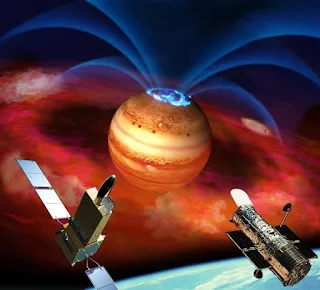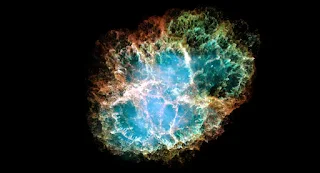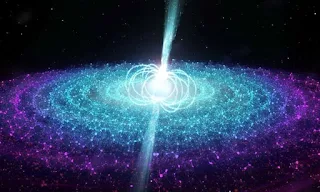Introduction:
A Natural electrical phenomenon
characterized by the appearance of streamers of reddish or greenish light in
the sky , especially near the northern or southern magnetic pole . The effect
is caused by the interaction of charged
particles from the sun with atoms in the upper atmosphere. In northern and
southern regions it is respectively called AURORA
BOREALIS or Northern lights and AURORA AUSTRALIS or Southern
Lights.
An
Aurora( plural : auroras or aurorae
) ,sometimes referred to as polar lights
, northern lights, southern lights , is a natural light
display in the earth’s sky, predominantly seen in the high – latitude regions.
Auroras are produced when the
magnetosphere is sufficiently disturbed by the solar wind that the trajectories
of charged particle in both solar wind and magnetospheric plasma, mainly in the
form of electrons and protons, precipitate them into the upper atmosphere due
to Earth’s magnetic field, where their energy is lost.
An
Aurora is the impressive end result of a series of events that starts at the
sun. The sun constantly emits a stream of charged particles known as the solar
wind into the depths of the solar
system. When these particles reach a planet, such as Earth, they interact with
the magnetic field surrounding it ( the magnetosphere ), compressing the field
into a teardrop shape and transferring energy to it.
Because
of the way the lines of a magnetic field can change, the charged particles
inside the magnetosphere can then be
accelerated into the upper atmosphere . Here they collide with molecules
such as nitrogen and oxygen, giving off energy in the form of light . This creates
ribbon of colour that can be seen across the sky close to the planet’s magnetic
north and south poles – this is the aurora.
Gas giant auroras:
Using
measurements from spacecraft, such as Cassini, or images from telescopes, such
as the Hubble Space Telescope, space physicists have been able to verify that
some of our closest neighbours have their own auroras. Scientists do this by
studying the electromagnetic radiation received from the planets, and certain
wavelength emissions are good indicators of the presence of auroras.
Each
of the gas giants (Jupiter, Saturn, Uranus and Neptune) has a strong magnetic
field, a dense atmosphere and as a result, its own aurora. The exact nature of
these auroras is slightly different from Earth’s, since their atmospheres and
magnetospheres are different. The colours, for example, depends on the gases in
the planet’s atmosphere. But the fundamental idea behind the aurora is the
same.
Interaction of solar wind:
The
solar wind is a constant outflow of electrons and protons from the Sun, always
present and buffeting Earth’s magnetic field. The background solar wind flows
at approximately one million miles per hour.
Even though auroras are best
seen at night, they are actually caused by the sun. The sun sends us more than
heat and light; it sends lots of other energy and small particles our way. The
protective magnetic field around Earth shields us from most of the energy and
particles, and we don’t even notice them.
But the sun doesn’t send same
amount of energy all the time. There is a constant streaming solar wind and
there are also solar storms. During one kind of solar storm called a coronal
mass ejection, the sun burps out a huge bubble of electrified gas that can
travel through space at high speeds.
When a solar storm comes toward us,
some of the energy and small particles can travel down the magnetic field lines
at the north and south poles into Earth’s atmosphere. There, the particles
interact with gases in our atmosphere resulting in beautiful display of light
in the sky. Oxygen gives off green and red light. Nitrogen glows blue and
purple.
A
typical aurora display consists of these forms appearing in the above order
throughout the night.
• Red: At the highest altitudes,
excited atomic oxygen emits at 630nm; low concentration of atoms and lower
sensitivity of eyes at this wavelength makes this colour visible only under
more intense solar activity. The low number of oxygen atoms and their gradually
diminishing concentration is responsible
for the faint appearance of the top parts of the “curtains”. Scarlet, Crimson
and carmine are the most often seen hues of red for the auroras.
• Green : At lower altitudes, the more frequent
collisions suppress the 630 nm mode: rather the 557.7 nm emission dominates.
Fairly high concentration of atomic oxygen and higher eye sensitive in green
makes auroras the most common.
•Blue: At lower altitudes,
atomic oxygen is uncommon, and molecular nitrogen and ionized molecular
nitrogen take over in producing visible light emission, radiating at a large
no. of wavelengths in both red and blue parts of the spectrum, with 428 nm
being dominant.
•Ultraviolet: Ultraviolet radiation form auroras have been
observed with the requisite equipment. Ultraviolet aurora have also been seen
on Mars, Jupiter and Saturn.
•Infrared: Infrared radiation, in
wavelengths that are within the optical window, is also part of many auroras.
•Yellow and pink are a mix of red and green or blue. Other shades of red, as
well as orange, may be seen on rare occasions.
How does the altitude effect the
colour of the aurora?
The
strong , green light originates at altitudes of 120km to 180km. Red northern
light occurs at even higher altitudes, while blue and violet occur mostly below
120km. When the sun is “stormy”, red colours occurs at altitudes of 90 to 100km.
Entirely red Northern lights may sometimes be seen, particularly at low
altitudes.
The different colours of aurora at
different altitude relates to the varying composition of the earths atmosphere
and its decreasing density moving away from the surface.
Auroras of different planets:
Earth’s Aurora:
The
resulting ionization and excitation of atmospheric constituents emits light of
varying colour and complexity. The form of aurora, occurring within bands around both the polar region.
Jupiter Aurora:
Jupiter’s main Auroral ring maintains a constant size. This is due to its
formation through interaction within its own magnetic environment. Jupiter’s
moon are also believed to be able to influence auroras.
Saturn Aurora:
On
Saturn, the strongest auroras are in the UV and infrared bands of the spectrum
and so would not visible to the human eye. But weaker pink and purple auroras
have also been spotted.
Venus Aurora:
Astronomers
love a good mystery, and here’s one they’ve pondered for decades. That is,
Venus may have green auroras despite the fact it has no magnetic field of its
own.
Mars Aurora:
On Mars, aurora appear near areas of
magnetised rock within the planet’s crust rather than near the poles, when charged
solar particles concentrate towards them. This type of aurora formation is
totally unique to mars as far as scientists are aware.
Summary:
Witnessing
an aurora first hand is a truly awe-inspiring experience. The natural beauty of
the northern or southern lights captures the public imagination unlike any
other aspect of space weather. But auroras aren’t unique
to Earth and can be seen on several other planets in our solar system.
An Aurora is the impressive end result of
series of events that starts at the sun. The sun constantly emits a stream of
charged particles known as the solar wind into the depths of the solar system.
When these particles reach a planet, such as Earth, Jupiter, they interact with
the magnetic field surrounding it, compressing the field into a teardrop shape
and transferring energy to it.
Because of the way the lines of a
magnetic field can change, the charged particles inside the magnetosphere can
then be accelerated into the upper atmosphere. Here they collide with molecules
such as nitrogen and oxygen, giving off energy in the form of light. This
creates a ribbon of colour that can be seen across the sky close to the
planet’s magnetic north and south poles- this is the Aurora.
SUBMITTED BY:
Priyalatha .M.
Ramyashri.
Preethi.
Sahana Rao L.N.
1st M.Sc. (2ndSemester)
SUBMITTED ON: 10th
April 2019
REFERENCE:
Internet
Journal






































